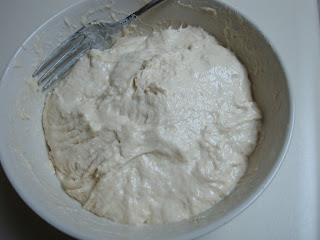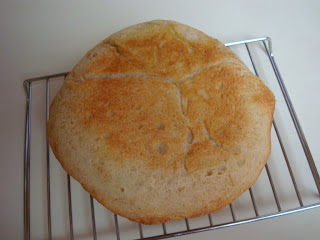Recipe: White bread with retarded fermentation
Ingredients:
Initial dough
- 2 cups of unbleached flour
- 1 cup + 3 TB warm water
- 1/2 teaspoon (tp) kosher salt
- 1 tp active dry yeast
Final dough
- some whole wheat flour for dusting
- 1.5 TB pesto paste
- 2 tp vegetable oil
Procedure:
Day 1:
1. Mix the flour with salt in a medium bowl.
2. Add 2-3 TB of warm water to the dry yeast to dissolve it.
3. Then add the dissolved yeast into the flour mixture. Start mixing the flour to form a dough. Add water in small amount of about 2-3 TB each time while mixing, until a wet dough is formed. The dough should be very sticky, yet it is able to pull away from the bowl in mostly one piece.
4. Chill in the fridge overnight. Occasionally take out to fold the dough a few times when possible.
Day 2:
1. Take the dough out of the fridge and fold it a little.
2. Allow to warm to room temperature for 2-3 hours.
3. Then set the dough on a counter dusted with flour. Fold it a few times. Cut into two pieces.
4. Fold each piece of the dough a few times. While folding, be very careful not to burst the air bubbles inside. The bubbles can be folded into the dough. It's not too easy to punch down the large bubbles, but it still helps to fold them into the center of the dough.
5. To make a white loaf, grease a small bowl with 1 tp of oil. Shape one piece of dough into a ball and place it into the bowl. Rub a little oil on top of the dough and allow to proof in the bowl.
6. To make a roll with pesto, carefully stretch out one piece of dough on the counter to. The thickness of the dough is about 1/4" to 1/2". Spread pesto paste thinly on the sheet. Then roll up the sheet. Grease a flat pan with 1 tp of oil. Allow the roll to proof on the pan.
7. After the two pieces of dough have increased in volume, preheat oven to 475F. Transfer the round loaf to the pan by inverting the bowl. The round loaf may not be able to keep its shape very well.
8. Score both loaves with a sharp knife dipped in water. Then place them in the oven. Turn oven setting to 400F and bake for 20 minutes.
9. Allow both loaves to cool. Then slice and serve.
Results:
Day 1
7:02pm, dough just mixed for about 20 minutes, with high hydration, but not to the point of a paste. Preparing to chill.
8:07pm, one hour after entering the fridge, dough has expanded, possibly because of the heat that still remains inside before the cold temperature sets in.
8:29pm, I decided to take dough out to knead it a little more. Observe that the wet dough does not stick to the plastic wrapper.
8:31pm, strength of the dough at this point:
8:35pm, I decided to put dough into a square pan with a little water at the bottom. This may facilitate folding in the future.
Day 2:
10:51am, look of the dough after one night of chilling:
10:53am, this is the stickiness of the dough when handled by a fork. Observe that the dough does not stick too much to the fork.
10:57am, dough has been folded a few times using the fork. Apparently, sufficient gluten has already developed since the initial mixing of the dough.
2:13pm, the risen dough after being left at room temperature for 3 hours:
2:20pm, dough first dusted with flour, then being folded by stretching.
2:22pm, observe the large bubble on the top right corner of the surface of the dough after it's been folded a few times. There are many such bubbles in the dough. Big as they are, they are actually rather resistant to the pressure of folding. Not easy to burst them or punch them down. The gluten that is wrapping them must be quite tough, remembering that this is a very lean dough with no fat at all.
2:28pm, dough cut into 2 pieces, one for a round white bread, one for a pesto roll:
2:32pm, the piece of dough for making the pesto roll has been stretched by hand on a counter dusted with flour. The bubbles still remain after the stretching.
2:35pm, pesto paste spread on the dough:
2:35pm, the piece of dough for the white loaf has been shaped into a ball, the other piece has been rolled up. Both are ready for proofing:
2:45pm, both loaves have been proofed 8 minutes:
3:13pm, both loaves have been proofed 33 minutes. Observe the distinctive volume increase in the round loaf:
3:21pm, loaves scored and ready to bake:
3:45pm, loaves baked at an oven preheated to 475F. Since both loaves are smaller, they are baked at a higher temperature (400F) for a shorter time (20 minutes) to achieve the browning of the crust. The oil on top of the loaves may also help give them the nice color.
3:46pm, white bread's top view:
3:46pm, white bread's side view:
3:46pm, white bread's bottom view:
4:33pm, white bread cooled and cut into 10 slices:
4:33pm, white bread's end-of-loaf slice:
4:33pm, white bread's center-of-loaf slice:
The other loaf has been given to a friend. So there is no record of how it looks inside.
Observations:
1. I am very satisfied with the volume of the white loaf, given the 1 tp of yeast to 2 cups of flour in the entire dough. The retardation has certainly produced a dough that has good fermentation.
2. The salt in the dough has not affected the fermentation too significantly in the process of retardation.
3. I have given the dough plenty of stretching while mixing the dough. Apparently, a large amount of gluten has already developed from the initial stage.
4. The strong gluten may have resulted from the fact that the dough is made of unbleached flour, salt and water alone.
5. The bubbles in the dough distribute primarily on the surface of the loaf. they may simply be the result of weight. I have yet to understand this phenomenon better. Nonetheless, this experiment has given me a very good starting point on making light white breads.
6. The oil rubbed onto the surface of the loaves have given their crusts a nice color.
7. For the roll, the oven spring is strong and the layer of the dough is thin. So the interior bursts out while baking!
Just imagine my joy when my husband waved a slice in the air and exclaimed, "this is very good!" It's the magic of a little yeast in flour, water and salt!




























No comments:
Post a Comment